Table of Contents
Are you looking for a way to effectively work on your glutes without having to go to the gym? If so, this is the article for you. Today we bring you the most effective bodyweight exercises for glutes that you can do just about anywhere. For these exercises, you won’t need any equipment, and they’re ideal for both beginners and advanced athletes, both of which can fully benefit from them on their journey to a round and firm booty. Read on and learn how to plan your workout for the best results with our example training.
Aside from the good old squats, this article will also explain how to do glute bridge, frog pump and other functional exercises that will involve your glutes from every angle. With these exercises, you will hit large, medium and small gluteal muscles, which is crucial for rounding out and shaping up your booty. This will allow you to construct a routine that will effectively move you towards your goals.
How to effectively exercise glutes with your bodyweight
How long does it take to see the results? Several factors come into play here, such as the amount of trainings you have in a week, the overall strain you put on your gluteal muscles, as well as what you eat and how much you rest. If you stick to a few basic rules, you can look forward to the first visible results within about a month.
- Pick 4 to 6 exercises from this list and make them a part of your training plan for at least four weeks. After that, you may want to switch some or even all of them around. That’s entirely up to you.
- Do your glutes workout 2 to 3 times a week. To ensure enough regeneration time, you should rest for at least 48 hours between such training sessions.
- After two to three weeks increase the rep range or the amount of sets performed for each individual exercise.
- When working out, always focus on performing the exercises with the proper technique.
- Exercise using the full range of motion that you are capable of while maintaining the proper technique. This way you will achieve maximum stretch of the exercised muscles, which is important to involve and activate it.
- To achieve those sexy curves, you often need to put on some muscle and get to a healthy level of body fat. Well-adjusted eating habits that provide you with the optimum amount of nutrients and energy is crucial in the process. You can calculate your optimum intake of nutrients and energy in our online calculator. [1–2, 4]
If you’d like to learn more about the complex glutes workout, find more information in our article How to Tone and Shape Your Butt and Legs.
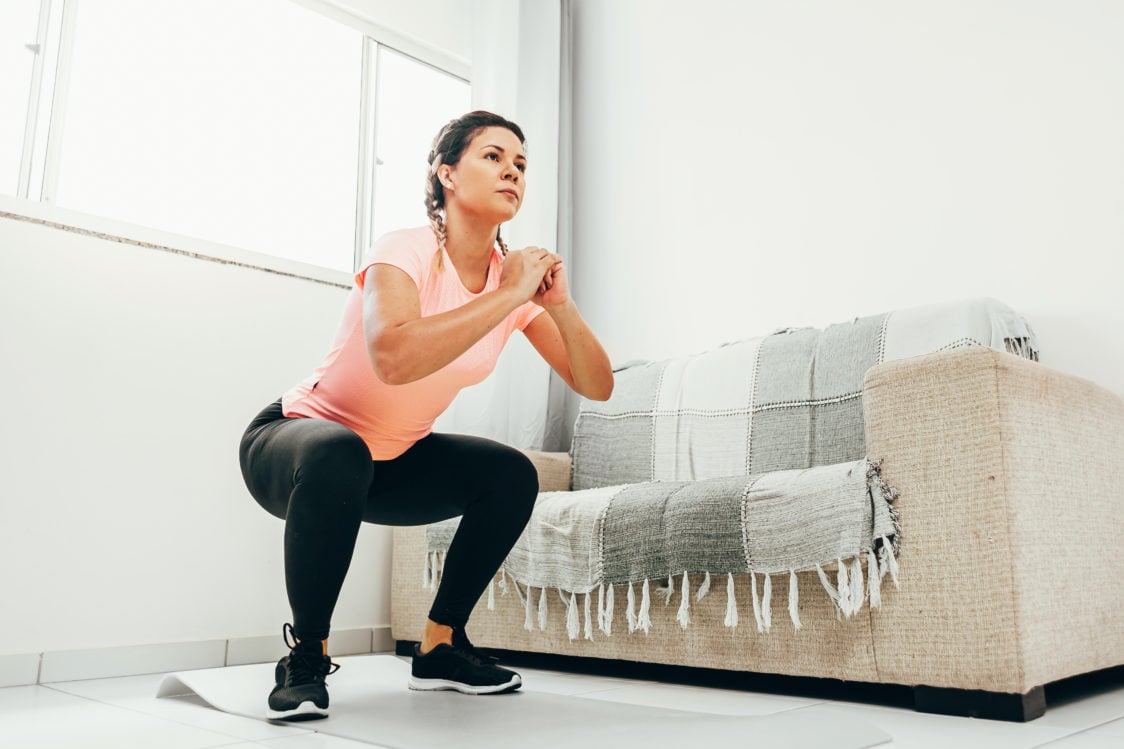
12 best bodyweight exercises for glutes
Pick from the basic and more advanced variations of the exercises listed here. Each one of the exercise descriptions also involves tips on accessories you can use if you decide to add extra challenge. When performing these exercises, always remember to maintain the proper technique. Keeping your back in a natural curve is crucial at every single one of these. Activating your core will be of great help.
1. Squats
- Initial position: Stand with your legs slightly apart, at about shoulder width, your weight resting on the entire surface of your feet.
- Execution: Inhale and push your pelvis back and down into a squat. While doing this, avoid rounding of the back in the lumbar and thoracic regions. Choose the depth of the squat so that you manage to maintain the natural curvature of the spine. The axis of the knee, ankle and toe of the foot remains in one plane. As you exhale, straighten your buttocks and the front of your thighs, activating them smoothly. Follow by another repetition.
- Common mistakes: Arching your back, small range of motion, leaning forward, knees caving in, uneven weight distribution, tiptoeing or heeling.
- Exercise variations: Single leg squat, squat pumps (going up and down in the range of several centimetres while remaining in the bottom position), jump squats.
- How to add challenge using fitness accessories: Squatting with a resistance band above the knees, with a fit ball overhead, on a balance trainer, using a weighted vest, with a barbell, kettlebell medicine ball or a powerbag.
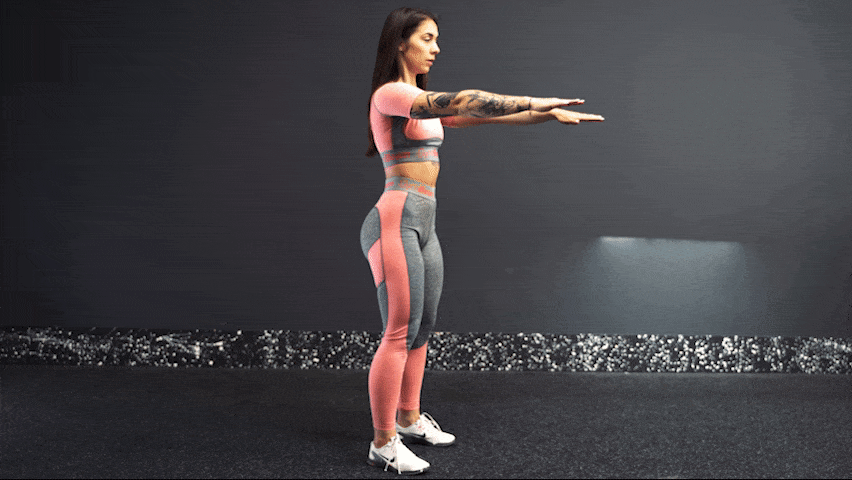
A more challenging variation: Jumping Air Squat
- Initial position: Stand with your legs slightly apart, at about shoulder width, your weight resting on the entire surface of your feet.
- Execution: Inhale and push your pelvis back and down into a squat. While doing this, avoid rounding of the back in the lumbar and thoracic area. Choose the depth of the squat so that you manage to maintain the natural curvature of the spine. The axis of the knee, ankle and toe of the foot remains in one plane. Exhaling, activate the muscles of your buttocks and the front of your thighs, jumping up. Inhale in the top position, then return to the squat and repeat the jump.
- Common mistakes: Arching in the back, small range of motion, leaning forward, knees turning inward, unevenly distributed weight, tiptoeing or heeling.
- Exercise variations: Tuck Jump – tuck your knees towards your chest while in the air.
- How to add challenge using aids: Squat jump onto a plybox or a balance trainer, using a powerbag.

2. Forward Lunges
- Initial position: Stand with your legs slightly apart with your hands at your sides.
- Execution: The tips of the feet and knees point in the same direction slightly to the sides throughout the entire movement. Begin by stepping forward and slightly to the side. Shift your weight onto your front foot. Get to a depth where your thigh is at about 90-degree angle in relation to your calf, or even a bit deeper. Exhaling and activating the muscles of the front of your thighs and buttocks, return to the starting position and immediately follow up with another repetition on the other leg.
- Common mistakes: Small range of motion, poor coordination of movement.
- Exercise variations: Jump Lunges, Backward Lunges, Pump Lunge.
- How to add challenge using fitness accessories: Lunges on a power mat, using a powerbag, weighted vest or a barbell.
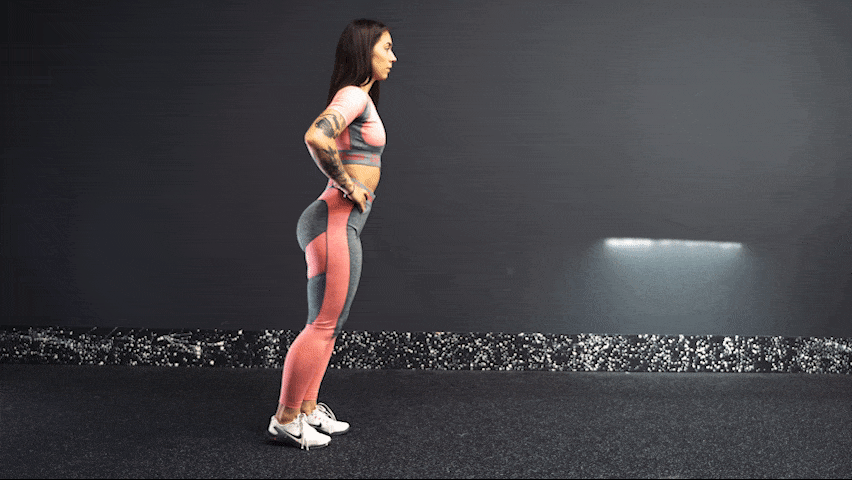
A more challenging variation: Jumping Lunges
- Initial position: Stand with legs slightly apart.
- Execution: The tips of the feet and knees point in the same direction slightly to the sides throughout the entire movement. Begin by stepping forward and slightly to the side. Shift your weight onto your front foot. Get to a depth where your thigh is at about 90-degree angle in relation to your calf, or even a bit deeper. Exhaling, activate the muscles of the front of your thighs and buttocks, jump up and switch legs while mid-air. At the impact with the floor, take a breath and immediately follow up with the next repetition. Use your hands to help maintain stability.
- Common mistakes: Small range of motion, poor coordination of movement.
- How to add challenge using fitness exercises: Jumping lunges onto a balance mat, using a power bag, weighted vest or a barbell.
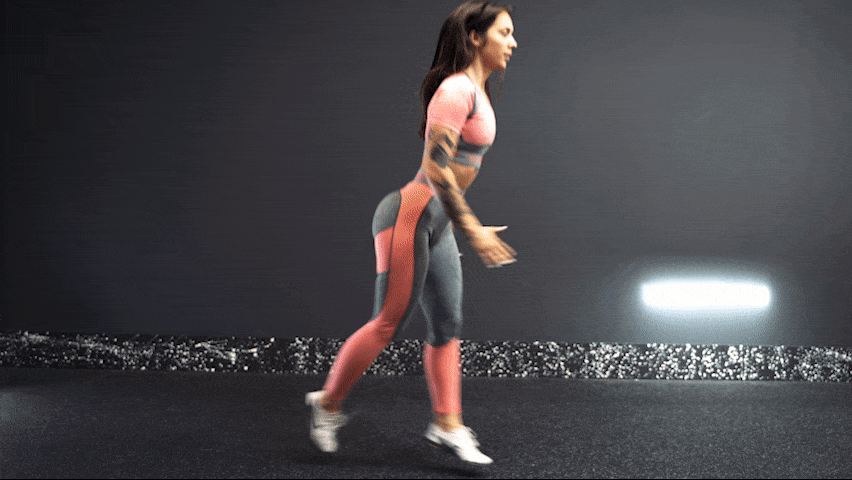
You might be interested in these products:
3. Standing Crab Walk
- Initial position: Stand with your feet apart at the width of your hips. Bend your knees slightly and push your pelvis back and down into a partial squat. The deeper your squat, the more challenging the exercise. Put your hands on your sides.
- Execution: As you exhale, take a step to the side with one leg and then bring the other leg towards the first one. Breathe in and then, as you breathe out, take a step in the opposite direction, switching legs. Keep alternating this way until you’ve finished your series.
- Common mistakes: Small range of motion, poor coordination of movement, bending in the back.
- How to add challenge using fitness accessories: Crab Walks with a resistance band above your knees or with a kettlebell held in both hands in front of your chest.
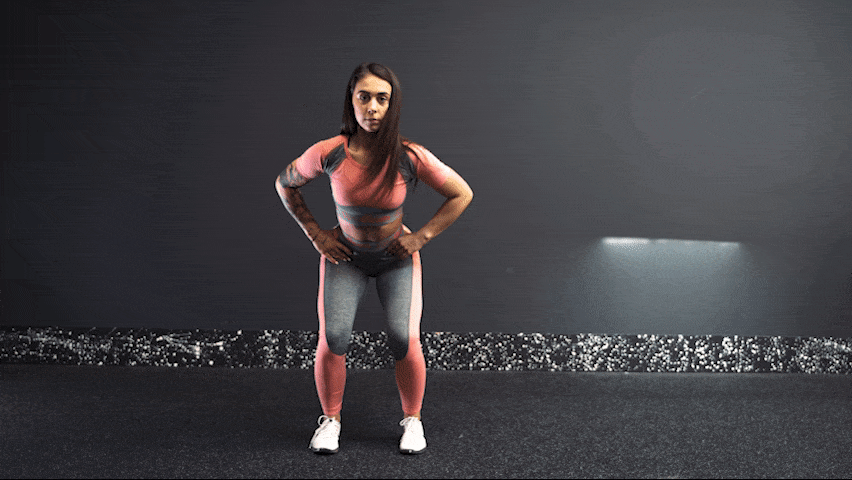
4. Curtsy Lunges
- Initial position: Stand with your legs slightly apart with your hands at your sides.
- Execution: With an inhale, cross your right leg behind the left one, bending both legs. You can lightly touch the mat with your right knee and then return to the starting position with an exhalation. Perform the same with your left leg, switching sides. Alternate sides in this manner until you complete your set.
- Common mistakes: Small range of motion, poor coordination of movement.
- Exercise variations: Curtsy Lunges with an intermediate jump
- How to add challenge using fitness accessories: Lunges using a powerbag, barbell or a weighted vest
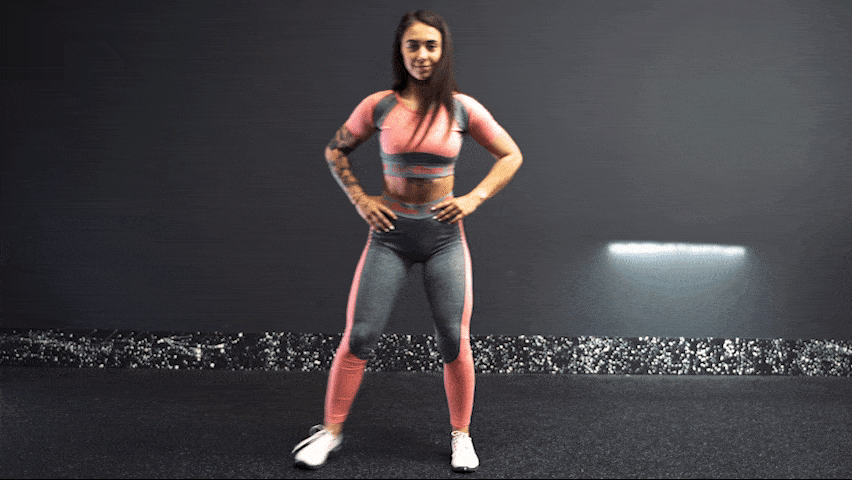
5. Bulgarian Split Squat
- Initial position: Stand in front of a chair, a couch or a plyometric box with your feet at hip width. Place the ball of one foot on the box or piece of furniture behind you and your hands on your sides.
- Execution: Inhale, bend the knee of your front leg and perform a lunge in place. In the low position, you can lightly touch the mat with the knee of the back leg. Then straighten up with an inhale and immediately follow up with another repetition. After one set, switch legs and perform the same exercise on the other side.
- Common mistakes: Small range of motion, poor coordination of movement.
- Exercise variations: Bulgarian Split Squat with a jump on the standing leg
- How to add challenge using fitness accessories: Bulgarian Split Squat with a powerbag, barbell, weighted vest or dumbbells.
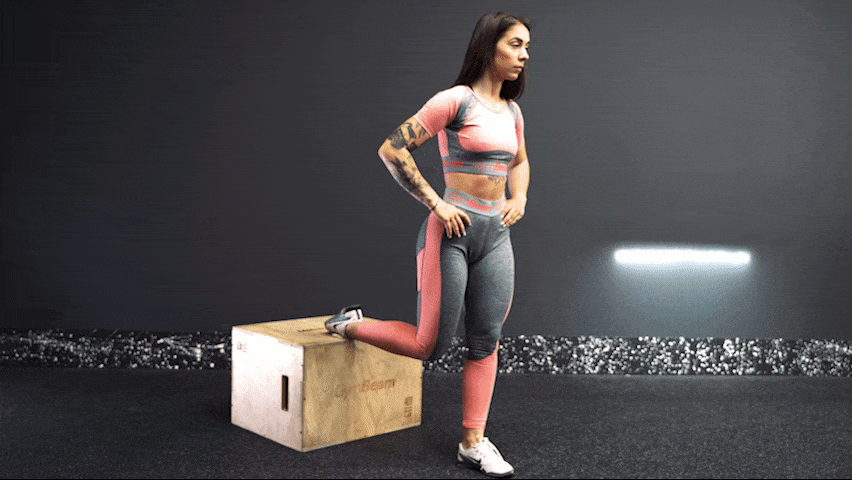
6. Glute bridge
- Initial position: Lie on your back and place your arms along your body with your palms on the floor. Bend your legs at the knees, pull them towards your buttocks and leave your feet on the ground.
- Execution: Lift your pelvis up by activating your glutes and hamstrings. In the upper position, focus on the contraction of the gluteal muscles. Hold for a second or two, then lower your pelvis back down in a controlled manner. Follow with the next repetition.
- Common mistakes: Small range of motion, insufficient activation of the gluteal muscles, excessive bending of the back, uncontrolled movement.
- Exercise variations: Isometric hold in the top position (20-30 seconds) or spread in the top position.
- How to add challenge using fitness accessories: Glute bridge with feet on a balance mat, using a wide resistance band placed above the knees, or with a kettlebell placed on the pelvis.
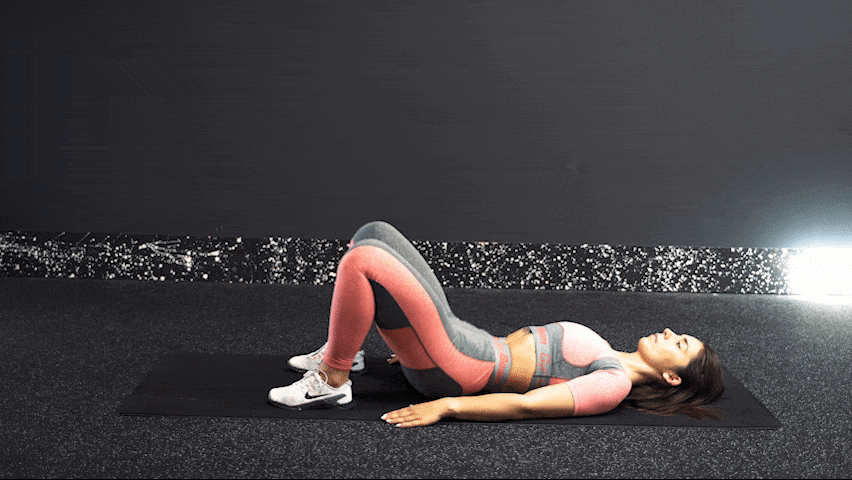
7. Frog pump
- Initial position: Lie on your back and place your arms along your body with your palms on the floor. Bend the legs at the knees, pull the feet towards the buttocks and turn them towards each other so that they touch.
- Execution: Lift your pelvis up by activating your glutes and hamstrings. In the upper position, focus on the contraction of the gluteal muscles. Hold for a second or two, then lower your pelvis back down in a controlled manner. Follow with the next repetition.
- Common mistakes: Small range of motion, insufficient activation of the gluteal muscles, excessive bending of the back, uncontrolled movement.
- Exercise variations: Isometric hold in the top position (20-30 seconds), pumping in the top position.
- How to add challenge using fitness accessories: Frog pump with legs on a balance trainer.
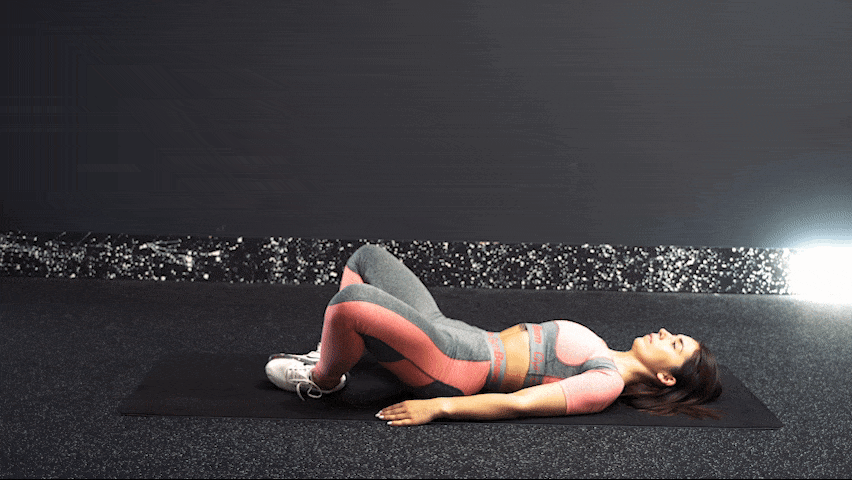
8. Single Leg Glute Bridge
- Initial position: Lie on your back and place your arms along your body with your palms on the floor. Bend both legs at the knees, bring your feet closer to your buttocks, then lift one leg up toward the ceiling.
- Execution: Lift your pelvis up by activating your glutes and hamstrings. Keep in mind that the leg that is lifted off the ground has to stay in the same position and the movement has to come from the pelvis only. In the top position, focus on the contraction of the gluteal muscles. Hold for a second or two, then lower the pelvis back down in a controlled manner. After one set, switch legs and perform the same exercise on the other side
- Common mistakes: Small range of motion, insufficient activation of the gluteal muscles, excessive bending of the back, uncontrolled movement.
- Exercise variations: Isometric hold in the top position (20-30 seconds), pumping in the top position.
- How to add challenge using aids: Single Leg Glute Bridge on a balance mat, using a wide resistance band placed above the knees, or with a kettlebell placed on the pelvis.
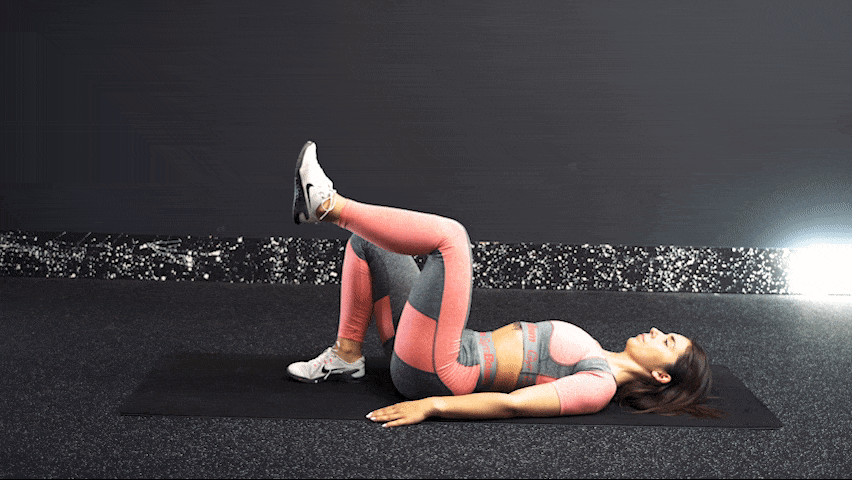
9. Fire Hydrant
- Initial position: Kneel on all fours.
- Execution: With exhalation, activate the muscles of the buttocks and bring one leg up and to the side while keeping it bent. Bring it back down with an inhalation and continue with the next repetition. After one set, switch legs.
- Common mistakes: Arching in the back, insufficient activation of the gluteal muscles, small range of motion.
- Exercise variations: Endurance hold or pumping in the upper position.
- How to add challenge using aids: Fire Hydrants with a wide resistance band or on a balance mat.
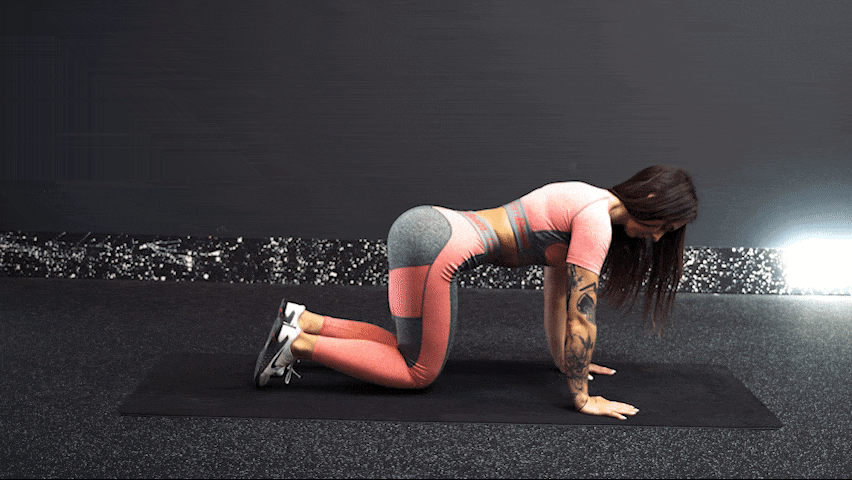
10. Straight Leg Kickback
- Initial position: Kneel on all fours, leaving one leg straightened out behind you.
- Execution: With exhalation, activate the glutes and kick the leg up. Bring it back down while inhaling and follow up with the next repetition. After one set, switch legs.
- Common mistakes: Arching in the back, insufficient activation of the gluteal muscles, small range of motion.
- Exercise variations: Endurance hold or pumping in the upper position.
- How to add challenge using aids: Straight Leg Kickbacks with ankle weights.
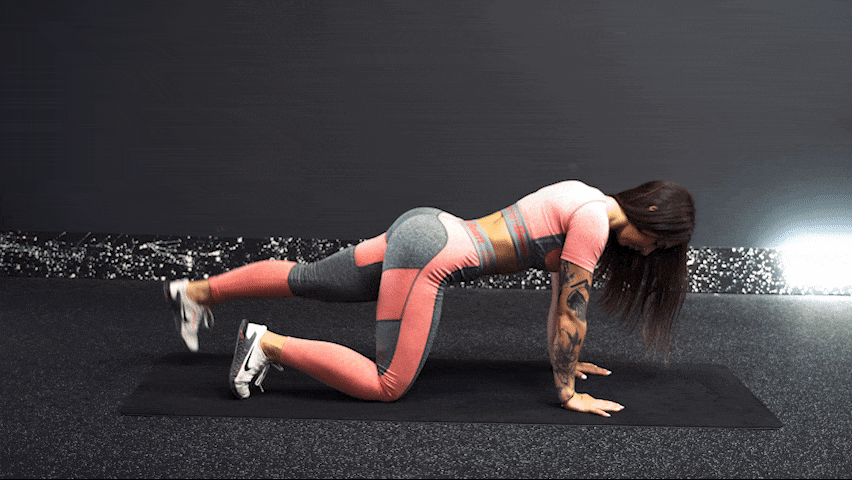
11. Single Leg Romanian Deadlift
- Initial position: Stand with legs slightly apart.
- Execution: The tips of your feet and your knees point in the same direction slightly to the sides throughout the entire movement. Shift your weight to the standing leg, which is slightly bent at the knee. With an inhale, bend forward and at the same time kick back the other leg, which remains stretched out. It is not necessary for the body to reach a parallel line with the ground in the lower position. Focus primarily on maintaining the natural curvature of the back and feeling the activation of your glutes and the backs of your thighs. At the beginning, it will be enough if you raise your leg 30-50 cm above the floor. Then return to the starting position with an exhalation. To enhance your stability, you can raise an arm, balancing out your weight distribution as you bend. Do several repetitions on one leg first, then switch legs.
- Common mistakes: Small range of motion, poor coordination of movement, bending in the back.
- Exercise variations: Using a chair for support and better stability.
- How to add challenge using aids: Single Leg Romanian Deadlifts with a kettlebell in hand, or a fit ball above your head, or performed on a balance mat or using a suspension trainer system.
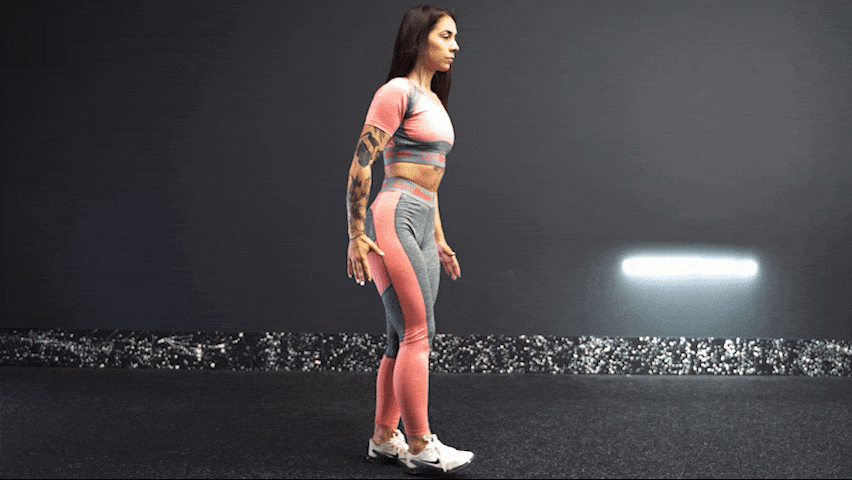
12. Wall Sit
- Initial position: Stand with your back against a wall, lean into it, and lower yourself into a squat position, ideally low enough that your thighs are parallel to the floor or even lower. The entire surface of the feet rests on the ground. You can place your hands on your thighs.
- Execution: Breathe steadily and try to stay in this position for at least 20 seconds. You can make the exercise a little more difficult if you do not rest your hands on your thighs, letting them hang freely alongside your body.
- Common mistakes: Insufficient duration of the exercise, insufficient squat depth
- How to add challenge using aids: Use a weight disc placed on your thighs or a kettlebell held in front of you with both hands.
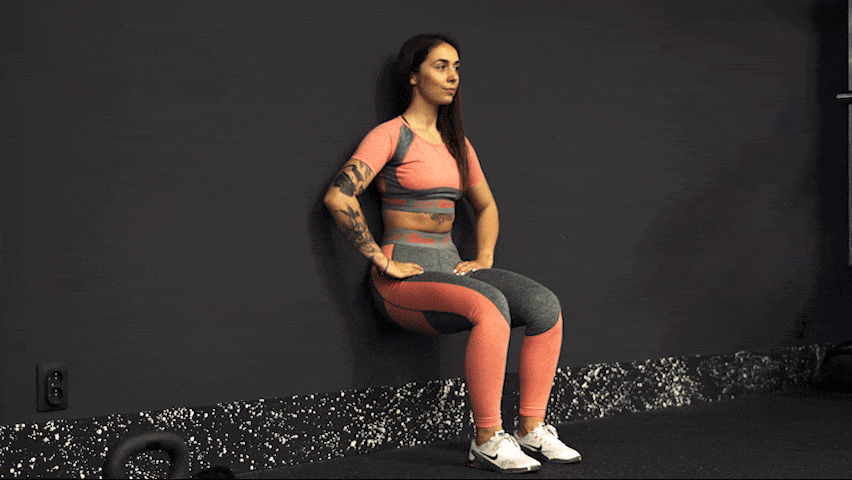
Example bodyweight booty workout
Before the workout, make sure to warm up by moving the whole body. Focus on loosening your hips and activating the muscles of the lower body. Then proceed to the main section of the routine with the exercises listed in the table. The number of sets for each exercise is 3-5. You can do all the sets of one exercise first and then move on to the next, or switch from one to the next to complete a circuit.
Take a 30 to 90 seconds long break between each exercise. After finishing the workout, add a cool-down phase that corresponds to your needs (slow jogging on the spot or walking) or stretch lightly. You can include this training routine into your overall training plan 2 or 3 times a week.
Exercise | Reps |
|---|---|
| Squats | 10–20 |
| Frog pump | 15–20 |
| Straight Leg Kickback | 15-20 reps per leg |
| Bulgarian Squats | 10-20 reps per leg |
| Curtsy Lunges | 10-20 reps per leg |
| Wall Sit | 20–45 seconds |
How to adjust the bodyweight booty workout for the advanced?
If you can already do 15 to 20 repetitions without feeling any muscle fatigue, you most likely got to the point at which your muscles will require further impulse to grow bigger and stronger. The following training tips can help you achieve that.
- Step by step, reduce the break time in between the exercises by 10 seconds.
- Include supersets, in which you go through two or more exercises in a row without taking a break.
- Combine static exercises with the dynamic ones. For example, follow an endurance hold in the squat position with a set of squat jumps.
- Add extra resistance with resistance bands, ankle weights, weighted vests, dumbbells, kettlebells or a barbell with weight discs. [3–4]
Would you like to learn more on how to work even harder at each training? Check out our article How to Make Your Home Workouts More Challenging Without Fitness Accessories.
Booty HIIT for the advanced
If you want to make sure your workout is quite challenging, try out this HIIT routine, which alternates longer intervals of exercise with much shorter breaks. Thanks to its high intensity, not only will you effectively work your glutes, you will also burn a lot of calories in just a short period of time.
- 40 seconds of exercise, 20 seconds of rest
- start with the exercise 1, then move on to the exercise 2, etc.
- rest for 1 to 2 minutes between the sets
- try to execute 3 to 5 sets
- depending on the number of sets you choose to do and the length of your breaks, the entire routine takes up between 17 to 33 minutes
- Jump Squat
- Wall Sit
- Lunges
- Jumping Lunges
- Glute Bridge
What’s next?
- You can try even more booty workouts using a fit ball following our article 10 Effective exercises Core & Booty Exercises with a Fit Ball.
- If you have a kettlebell at home, you can find a variety of lower body exercises using this handy tool in our article 8 Best Booty & Leg Exercises with a Kettlebell.
- You can also build a booty routine using resistance bands, following our article Get a Firm and Round Butt Without a Barbell. Try Resistance Band Workout.
What’s the take home message?
Including these bodyweight booty exercises into your routine can be a fun way to spice up your training a little. All of these can be done in the comfort of your own home, in a garden, park, or a workout playground. They will help you hit your glutes in a complex and effective way, taking you one step further to the perfectly shaped booty of your dreams.
Try out a regular routine with the recommended rep ranges, or a more advanced HIIT training. To increase the challenge, incorporate the more advanced variations or add extra resistance with dumbbells or resistance bands.
Did you find this article useful? If so, share it with your friends and help them get inspired in their workouts!
[1] Muscle & Strength. 8 Week Muscle Building Bodyweight Workout. – https://www.muscleandstrength.com/workouts/8-week-muscle-building-bodyweight-workout
[2] Trinh, E. Can Bodyweight Exercises Build Glutes (Yes, Here’s How) – Fitbod. – https://fitbod.me/blog/can-bodyweight-exercises-build-glutes/
[3] Muscle & Fitness. Build the Ultimate Bodyweight Routine. – https://www.muscleandfitness.com/workouts/workout-routines/build-ultimate-bodyweight-workout-routine/
[4] Duquette, S., & PTS, M. W.-N., BHSc. How to Bulk Up at Home Without Any Equipment. – https://bonytobeastly.com/bodyweight-workout-for-muscle-mass/

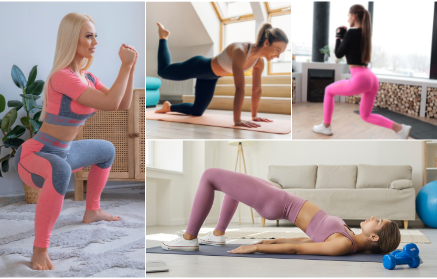
Add a comment